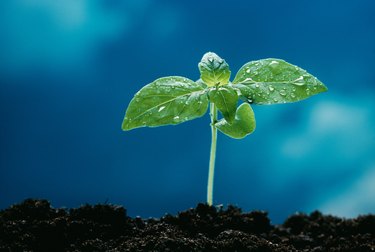
Grow lights are used in controlled plant-growing environments that lack sufficient sunlight. There are many different types but only a few have the ability to replicate up to 98% of the full spectrum of the sun. The type of light needed for specific plants will determine what kind of bulbs you should use. Different lighting systems each have their own safety concerns. Hazards generally involve heat build-up and frayed or faulty connections.
High Intensity Discharge Systems
Video of the Day
High intensity discharge lamps (HID) are used for total replacement of the sun as a grow light source rather than a simple supplement. Twice as many lumens are produced by these lights for the same amount of energy normally used by a regular incandescent or fluorescent bulb. These HID sources may include mercury vapor, mercury halide and high-pressured sodium.
Video of the Day
Each variety requires different ballasts than standard bulbs. They are not interchangeable, even if they seem to fit. Furthermore, HID tends to be a high wattage system that can produce excessive loads on electrical systems. Short circuits and overloads are a matter of special concern with an HID lamp. Always verify that your ballast is compatible with the bulb you are using.
Occasionally, bulbs may explode. With HID lights, breakage can be a serious hazard. According to the EPA, mercury is highly toxic. Not only will it pose an immediate danger to anyone in the vicinity, but it can contaminate the soil and plants underneath the shattered glass. Take precautions to minimize this danger by ensuring lights are securely installed and equipped with a protective lens. Follow the "What to Do if a Fluorescent or Other Mercury-Containing Light Bulb Breaks" instructions on the EPA website if an accident occurs.
Fluorescent Bulbs
Consider using full spectrum fluorescent bulbs if you only need to supplement sunlight and not completely replace it. Select grow light bulbs with non-toxic coatings so breakage will not create a chemical hazard. Do not keep these lights on all the time. Using lamps for 24 hours in a row can increase the risk of fire hazard. In addition, maturing plants must have at least 6 hours of darkness for proper respiration. To further reduce the risk of heat build-up and fire, consider LED light sources as an alternative to fluorescent bulbs.
General Safety
Wear eye protection when you work in a greenhouse with this equipment. Some of these lights are similar to those in tanning salons and emit UV radiation. Protecting your skin is a good idea if you will be working in close proximity to these lights for any length of time. Also, check any surfaces that are illuminated with HID lamps for excessive heat build-up. If a surface is hot to the touch, increase the distance between the grow light and the surface in question or move the item out of the path of illumination.
Place your hand directly into the space where the plants will be growing. If you feel any heat, the lamp is too close. For low wattage systems the proper distance will be about 2 to 3 feet away from the tops of the plants. For high wattage systems, this distance is often 4 to 6 feet.
Using electricity in a gardening environment that will be regularly watered can be dangerous. Keep all cords and fixtures far enough away from your irrigation system so that they do not come into contact with water. The same rules apply whether you water by hand or grow plants using hydroponics.